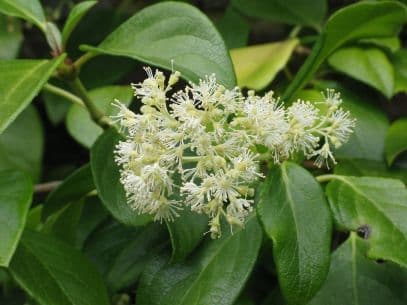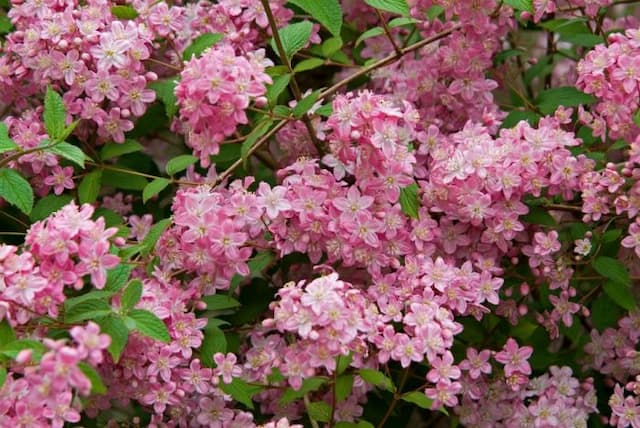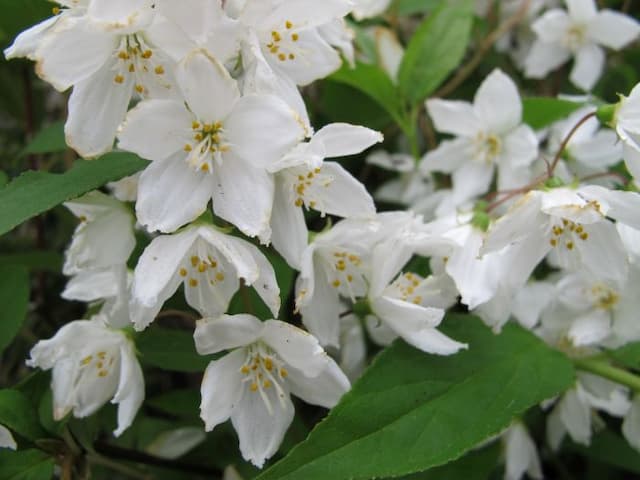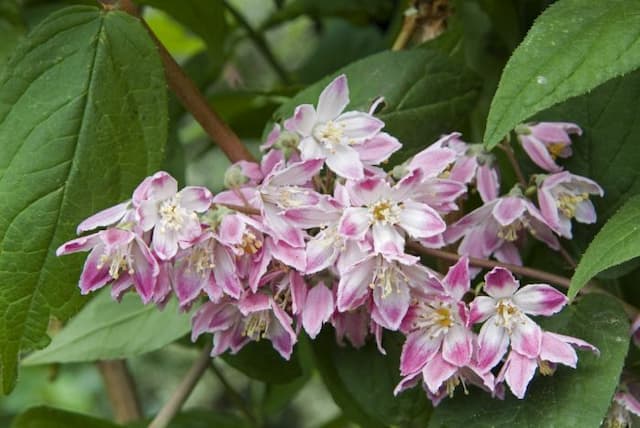Hydrangea serrata (Amacha Group) 'O-amacha' (L)

ABOUT
Hydrangea serrata, commonly known as mountain hydrangea, 'O-amacha' from the Amacha Group, is a shrub notable for its beautiful and distinctive appearance. The plant is characterized by its large, flat flower heads which are a lacecap type, meaning they have a central core of subdued, tiny, fertile flower buds that are surrounded by a ring of prominent, larger, sterile flowers. These showy flowers range in color from blue, pink to light purple, depending on the soil pH; in acidic conditions, the flowers tend to be blue, while in neutral to alkaline soils, they become pink or purple. The leaves of the mountain hydrangea are another appealing feature, being ovate or elliptical, with a serrated edge giving a slightly ruffled texture. They typically have a lush, green color, adding an attractive backdrop to the stunning blooms. The foliage in the fall can turn to shades of red or yellow, providing seasonal interest. Stems arch gracefully and are often covered in a exfoliating bark, revealing a rich under layer that adds to the visual interest in winter. Delicate buds emerge from these stems, which burst into abundant flowering in the appropriate season. The overall form is compact, with a bushy and mounded shape, lending it well to a variety of garden settings where it can create a stunning visual impact.
About this plant
 Names
NamesFamily
Hydrangeaceae
Synonyms
Mountain Hydrangea, Tea Of Heaven, Sweet Tea Hydrangea, Japanese Mountain Hydrangea
Common names
Hydrangea serrata 'Oamacha', Hydrangea serrata var. thunbergii.
 Toxicity
ToxicityTo humans
Mountain hydrangea is considered to have a low level of toxicity to humans. However, if ingested in large quantities, parts of the plant, particularly the leaves and buds, can cause gastrointestinal distress, such as vomiting and diarrhea, due to the presence of compounds like hydrangin. It is important for individuals, especially children, who might be tempted by the attractive flowers, to avoid consuming any parts of this plant.
To pets
For pets, notably cats and dogs, mountain hydrangea can be toxic. The plant contains compounds such as hydrangin, which can lead to symptoms like vomiting, diarrhea, and lethargy if ingested. Although the plant is not typically considered highly toxic, it is still advisable to prevent pets from eating any parts of the plant to avoid the potential for poisoning and the distressing symptoms that may follow.
 Characteristics
CharacteristicsLife cycle
Perennials
Foliage type
Deciduous
Color of leaves
Green
Flower color
Pink
Height
2-4 feet (0.6-1.2 meters)
Spread
2-4 feet (0.6-1.2 meters)
Plant type
Shrub
Hardiness zones
6
Native area
Japan
Benefits
 General Benefits
General Benefits- Aesthetic Appeal: The 'O-amacha' hydrangea provides visual interest to gardens with its vibrant foliage and picturesque blossoms, enhancing the beauty of any landscape.
- Seasonal Interest: It offers a long flowering season, typically from late spring to early autumn, providing color throughout these months.
- Pollinator-friendly: Its flowers attract pollinators such as bees and butterflies, supporting local biodiversity.
- Cultural Significance: In Japan, hydrangeas like 'O-amacha' have cultural importance and are celebrated during events like the rainy season or in tea ceremonies.
- Versatile Landscaping: Hydrangea serrata can be used in a variety of gardening applications, such as borders, foundation plantings, or as specimen plants.
- Tolerance of Soil pH: This plant can tolerate a range of soil pH levels, and the flower color can change from pink to blue depending on the soil acidity, which is interesting for gardeners who like to experiment with soil chemistry.
 Medical Properties
Medical Properties- Anti-allergy: Hydrangea serrata, commonly known as mountain hydrangea, has been traditionally used to alleviate allergic reactions, particularly in the treatment of hay fever.
- Antioxidant: The leaves of the mountain hydrangea contain phytochemicals that have antioxidant properties, which can help in neutralizing harmful free radicals in the body.
- Detoxification: In some traditional medicine systems, mountain hydrangea is believed to help detoxify the body, although scientific evidence to back this claim is limited.
 Air-purifying Qualities
Air-purifying QualitiesThis plant is not specifically known for air purifying qualities.
 Other Uses
Other Uses- Hydrangea tea - Leaves of the Hydrangea serrata, particularly the 'O-amacha' cultivar, are used to produce a sweet tea traditionally used in Japanese Buddha's Birthday celebrations.
- Ritual use - In Japan, the tea made from the leaves is poured over Buddha statues in a ritual known as Kanbutsu-e, indicating respect and reverence.
- Landscape design - Due to its ornamental value, the plant is commonly used in garden design to provide aesthetic appeal with its attractive foliage and flowers.
- Soil pH indicator - Like other hydrangeas, the color of 'O-amacha' flowers can indicate the pH level of the soil, with acidic soils bringing out blue tones and alkaline soils leading to pinker flowers.
- Dye source - The plant can be used to create natural dyes for fabrics, with various parts of the plant producing different hues.
- Bonsai - 'O-amacha' can be cultivated as a bonsai for decorative purposes, showcasing miniature forms of its beautiful foliage and blooms.
- Edible blooms - The flowers of the Hydrangea serrata can be crystallized and used to decorate desserts or consumed as part of edible flower arrangements.
- Folklore and symbolism - In some cultures, hydrangeas carry symbolic meanings and are used in various traditional practices, including wedding ceremonies and other cultural events.
- Butterfly attraction - The flower clusters are known to attract butterflies and other pollinators, beneficial for biodiversity in gardens.
- Seasonal festivals - Hydrangea blossoms are often celebrated during the rainy season in Japan, with festivals showcasing the beauty of these plants in full bloom.
Interesting Facts
 Feng Shui
Feng ShuiMountain Hydrangea is not used in Feng Shui practice.
 Zodiac Sign Compitability
Zodiac Sign CompitabilityMountain Hydrangea is not used in astrology practice.
 Plant Symbolism
Plant Symbolism- Gratitude & Apology: In Japan, hydrangeas (Ajisai) are often associated with gratitude for understanding and apology. This stems from a legend where an emperor gifted blue hydrangeas to the family of a girl he loved to apologize for neglecting her.
- Heartfelt Emotions: The lush and abundant blooms of hydrangeas symbolize the fullness of emotion and can be used to express deep feelings.
- Understanding: The variety and color diversity among hydrangea flowers represent comprehension and patience in relationships, signaling a deep level of understanding between individuals.
- Pride: Hydrangeas can also symbolize boastfulness or vanity, due to the abundant and eye-catching blooms.
- Perseverance: As plants that can grow in various soil conditions and climates, hydrangeas convey a message of persistence and endurance.
- Fourth Wedding Anniversary: In Western culture, hydrangeas are commonly given on fourth wedding anniversaries to symbolize appreciation and everlasting love.
 Water
WaterMountain hydrangeas like 'O-amacha' should be watered deeply, ensuring the soil is moist but not waterlogged. They typically require about 1 gallon of water per week, but this can vary depending on climate conditions; during hot, dry periods, they may need to be watered twice a week. The best method is to water at the base of the plant, avoiding wetting the foliage, to reduce the risk of leaf diseases. It's crucial to reduce watering in the winter when the plant is dormant. Always check the top inch of the soil for dryness before watering; if it's dry, it's time to water.
 Light
LightMountain hydrangeas like 'O-amacha' thrive in partial shade, where they can receive some dappled sunlight but are protected from the harsh afternoon sun. A location with morning sunlight and afternoon shade is ideal to encourage blooming without causing heat stress. Avoid deep shade as this can lead to reduced flowering.
 Temperature
TemperatureThe 'O-amacha' mountain hydrangea prefers a temperate climate and can tolerate temperatures as low as 20°F without significant damage. However, their ideal growing temperature is between 50°F and 80°F. They can survive brief periods of higher temperatures, but sustained heat above 85°F can be stressful for the plant.
 Pruning
Pruning'O-amacha' should be pruned to remove dead wood and encourage new, healthy growth. It's best to prune in late winter or early spring before new growth begins. This type of hydrangea blooms on old wood, so be careful not to prune off the buds for the upcoming season. Occasional thinning of the plant can help increase light and air circulation, promoting better health and bloom.
 Cleaning
CleaningAs needed
 Soil
SoilMountain Hydrangea prefers well-draining, moist soil with high organic matter. A soil pH of 5.5 to 6.5 is ideal for this plant, which can affect bloom color.
 Repotting
RepottingMountain Hydrangeas should be repotted every 2-3 years to replenish soil nutrients and allow room for root growth.
 Humidity & Misting
Humidity & MistingMountain Hydrangeas thrive in moderate to high humidity levels, ideally between 60% and 70%.
 Suitable locations
Suitable locationsIndoor
Bright, indirect light and consistent moisture support indoor Mountain Hydrangeas.
Outdoor
Plant in partial shade, shelter from strong winds, and keep soil moist.
Hardiness zone
Mountain Hydrangea is suitable for USDA zones 6-9.
 Life cycle
Life cycleHydrangea serrata (commonly known as the mountain hydrangea) begins its life cycle when seeds germinate in moist, well-drained soil in a shaded area. Seedlings emerge and grow into young plants with distinctive serrated leaves. As the plants mature, they develop woody stems and can reach a height of up to 1.2 meters with a broad, bushy growth habit. During the growing season, typically in early summer, the mountain hydrangea produces clusters of flowers, which may be blue, pink, or purple depending on the soil pH, with fertile florets surrounded by larger sterile florets. After pollination, the flowers develop into capsule-like fruits, which release seeds to perpetuate the plant's life cycle. In the winter, the mountain hydrangea enters dormancy, with the above-ground parts dying back, while the below-ground parts, such as roots and buds, survive to sprout again in spring.
 Propogation
PropogationPropogation time
Spring-early summer
Propogation: The most popular method of propagating Hydrangea serrata 'O-amacha', commonly known as mountain hydrangea, is through softwood cuttings. This is best done in late spring or early summer when the plant's new growth is still tender but has begun to mature. To propagate, you should select healthy, new growth shoots and cut a 4 to 6-inch (approximately 10 to 15 cm) section of the stem, making sure there are at least three sets of leaves. The bottom set of leaves should be removed, and the cut end of the stem can be dipped in rooting hormone to increase the chances of successful rooting. The cutting should then be planted in a well-draining potting mix and kept in a humid environment with indirect light until roots have developed, which usually takes about 4 to 6 weeks. After the roots have established, it can be transplanted to a more permanent location.






![Rose deutzia [Yuki Cherry Blossom]](/_next/image?url=https%3A%2F%2Fplants-admin.emdemapps.com%2Fimages%2Fplants%2F%2Fimages%2F604b6510a383a.png&w=640&q=75)

![Hydrangea [Hot Chocolate]](/_next/image?url=https%3A%2F%2Fplants-admin.emdemapps.com%2Fimages%2Fplants%2F%2Fimages%2F604b5a066e3bd.png&w=640&q=75)
![Hydrangea [Blackberry Pie]](/_next/image?url=https%3A%2F%2Fplants-admin.emdemapps.com%2Fimages%2Fplants%2F%2Fimages%2F604b56e2abc1d.png&w=640&q=75)